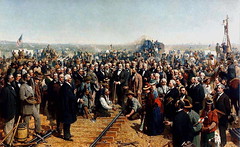Hidden History: Driving the Last Spike of the Transcontinental Railroad was an Early Version of the Internet of Things

The story of driving the golden spike to symbolize the completion of the transcontinental railroad is famous in the US. What is not so well known is the story of how it also foreshadowed changes to come as an early version of both the Internet and the Internet of Things. But that was 1869, how can that possibly be?
Telegraph as Internet
First, let's establish the telegraph and cable systems was an early version of an Internet.
As railroad tracks were being laid a transcontental telegraph system was also being constructed. Telegraph lines were installed parallel to the tracks making instant communication available across the continent, faster than any horse could ride.
With the transalantic cable system information could quickly span continents in minutes:
The miles of American telegraph grew from 40 in 1846 to 12,000 in 1850 to 23,000 in 1852. In Europe it increased from 2,000 in 1849 to 110,000 in 1869. The cost of sending 10 words was $1.55 in 1850, $1 in 1870, 40¢ in 1890. Within 29 years of its first installation at Euston Station, the telegraph network crossed the oceans to every continent but Antarctica, making instant global communication possible for the first time. The telegraph's greatest accomplishment was to expand information boundaries, allowing data to reach its destination before its usefulness expired to a decisively higher degree than before, particularly in trade.
Protocols Not Just Morse Code
If your image of communication over the telegraph is simple Morse code then prepare to be bedazzled. First, Morse code is a binary protocol, like any form of serial communication we use today. A telegraph is basically a fast switch for encoding dots and dashes as short and long electrical pulses. Long strings of wires were connected via relays so telegraph lines could cover vast distances. Sound familiar?
The problem with Morse code is that it's not very information dense, so elaborate protocols were built on top of the Morse code vocabulary. There's a whole hidden history behind using the telegraph that is remarkably like modern data encoding and packet transmission techniques.
For example, because bandwidth was limited code books were developed for nearly every industry as a way of compressing data to save money on transmission costs. A matching phrase or sentence would be replaced by a code word. It's estimated 95% of all transatlantic telegraph traffic was encoded as was a high percentage of domestic traffic. Not only was compression used, but messages from different customers were batched together as way of saving money. Sound familiar?
Internet of Things
So how does all that get us to the Internet of Things? Check this out:
On May 10, 1869, as the last spike was driven in the Utah desert, the blows were heard across the country. Telegraph wires wrapped around spike and sledgehammer transmitted the impact instantaneously east and west. In San Francisco and New York, wires had been connected to cannons facing outward across the ocean. When the signal from the spike came through, the cannons fired. The world was put on notice: the transcontinental railroad was completed and America was moving to the forefront of the world's stage.
Here we have things, a spike and sledgehammer, connected electrically to a telegraph sending a message over the telegraph to remotely controlled cannons half a continent away. It's a straight up maker hack minus the Raspberry Pi. But you don't need fancy sensors connected to Arduino board sporting a wireless protoshield to get stuff done. They did IoT to perfection in 1869. How great is that?




